移动商城第五篇【前台展示、后台筛选】
前台准备
web.xml
<listener>
<listener-class>org.springframework.web.context.ContextLoaderListener</listener-class>
</listener>
<context-param>
<param-name>contextConfigLocation</param-name>
<param-value>classpath:beans.xml</param-value>
</context-param>
<servlet>
<servlet-name>springmvc</servlet-name>
<servlet-class>org.springframework.web.servlet.DispatcherServlet</servlet-class>
<init-param>
<param-name>contextConfigLocation</param-name>
<param-value>classpath:springmvc.xml</param-value>
</init-param>
</servlet>
<servlet-mapping>
<servlet-name>springmvc</servlet-name>
<url-pattern>*.do</url-pattern>
</servlet-mapping>
<filter>
<filter-name>SpringCharacterEncodingFilter</filter-name>
<filter-class>org.springframework.web.filter.CharacterEncodingFilter</filter-class>
<init-param>
<param-name>encoding</param-name>
<param-value>UTF-8</param-value>
</init-param>
</filter>
<filter-mapping>
<filter-name>SpringCharacterEncodingFilter</filter-name>
<url-pattern>*.do</url-pattern>
</filter-mapping>
springmvc
<?xml version="1.0" encoding="UTF-8"?>
<beans xmlns="http://www.springframework.org/schema/beans"
xmlns:xsi="http://www.w3.org/2001/XMLSchema-instance"
xmlns:context="http://www.springframework.org/schema/context"
xsi:schemaLocation="http://www.springframework.org/schema/beans
http://www.springframework.org/schema/beans/spring-beans-3.0.xsd
http://www.springframework.org/schema/context
http://www.springframework.org/schema/context/spring-context-3.0.xsd
">
<context:component-scan base-package="com.rl.ecps.controller"/>
<bean class="org.springframework.web.servlet.view.InternalResourceViewResolver">
<property name="prefix" value="/WEB-INF/shop/"></property>
<property name="suffix" value=".jsp"></property>
</bean>
</beans>
访问首页:
@Controller
@RequestMapping("/item")
public class EbItemController {
@RequestMapping("toIndex.do")
public String toIndex() {
return "index";
}
}
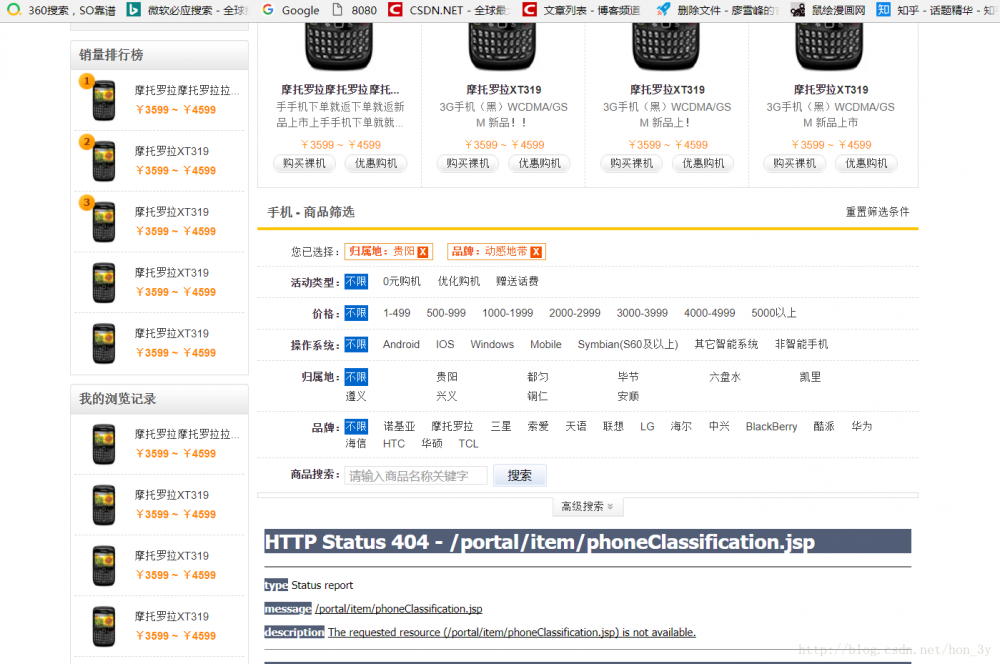
由于下面使用了iframe,于是就出现了404错误了。 src是不能直接获取WEB-INF的JSP的。
<iframe id="itemListIframe" src="phoneClassification.jsp" frameBorder=0 scrolling=no width="100%" height="200%" ></iframe>
于是乎,我们把地址修改成访问controller,controller做跳转就行了。
<iframe id="itemListIframe" src="${path}/item/phoneClassification.do" frameBorder=0 scrolling=no width="100%" height="200%" ></iframe>
@RequestMapping("phoneClassification.do")
public String phoneClassification() {
return "phoneClassification";
}
设置完之后我们就可以能看到页面了。
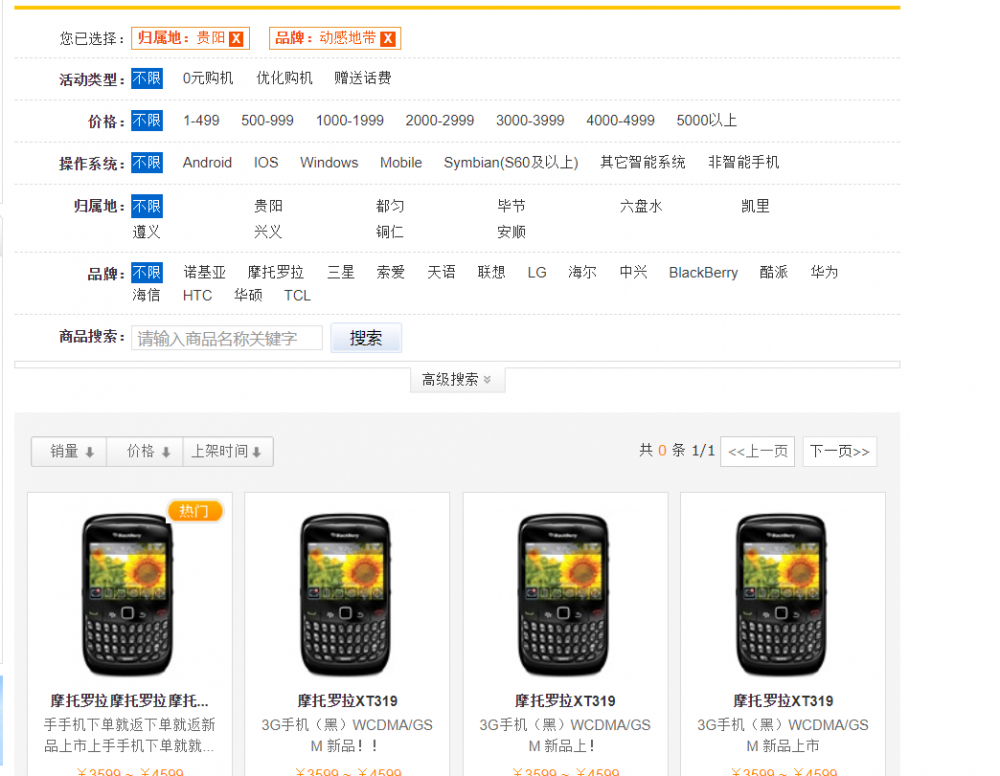
筛选后台
我们要做的就是, 通过前台给出的参数,我们后台筛选出数据在前台展示。
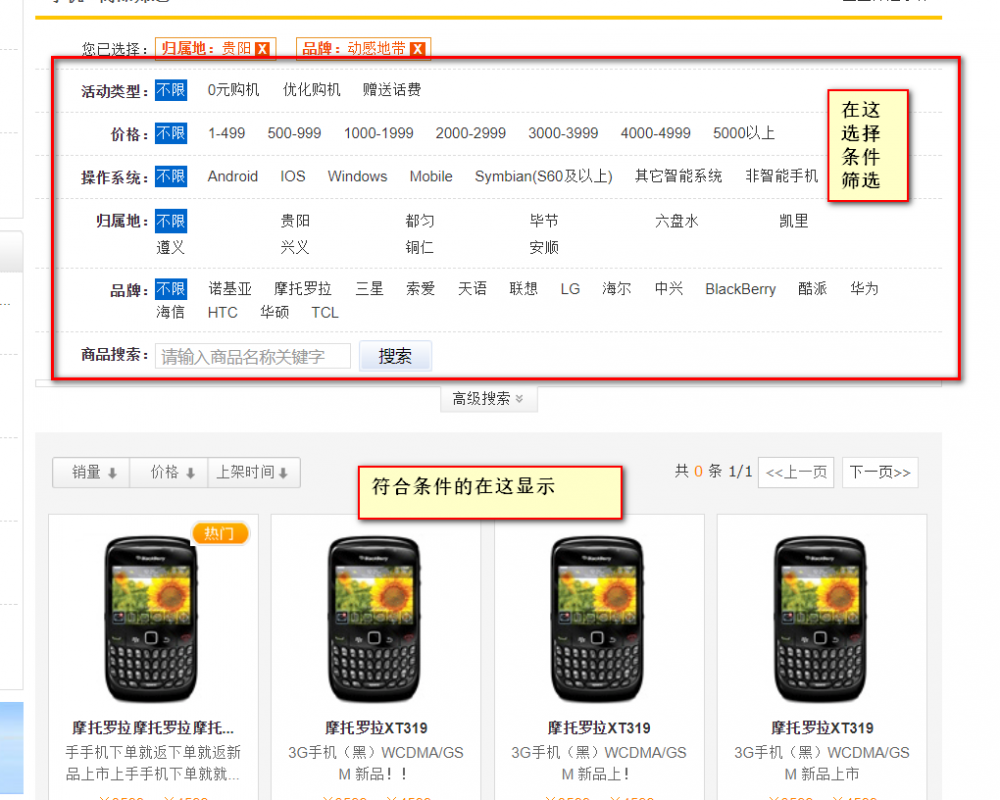
首先,我们来分析一下可以筛选的参数把:
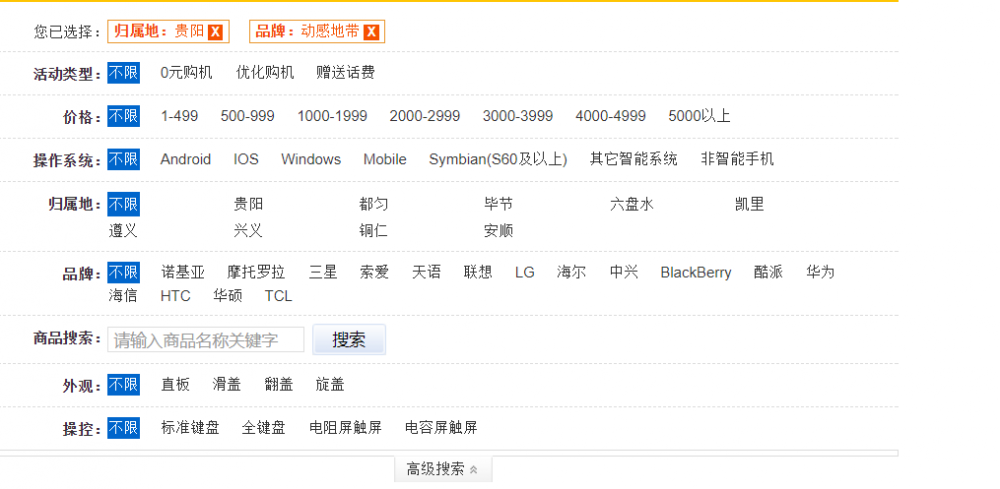
从参数上我们可以分为几类:
- 价钱
- 品牌
- 基本属性参数
首先,我们把所有品牌先查询和对应的参数先查询出来吧。
@RequestMapping("toIndex.do")
public String toIndex(Model model) {
List<EbBrand> ebBrands = brandService.selectBrand();
List<EbFeature> isSelect = featureService.selectIsSelect();
model.addAttribute("ebBrands", ebBrands);
model.addAttribute("isSelect", isSelect);
return "index";
}
在页面上做展示
<c:forEach items="${isSelect}" var="feature">
<li style="display:none"><b>${feature.featureName}:</b>
<p>
<a href="javascript:void(0);" title="不限" class="here">不限</a>
<c:forEach items="${feature.selectValues}" var="val">
<a href="javascript:void(0);" >${val}</a>
</c:forEach>
</p>
</li>
</c:forEach>
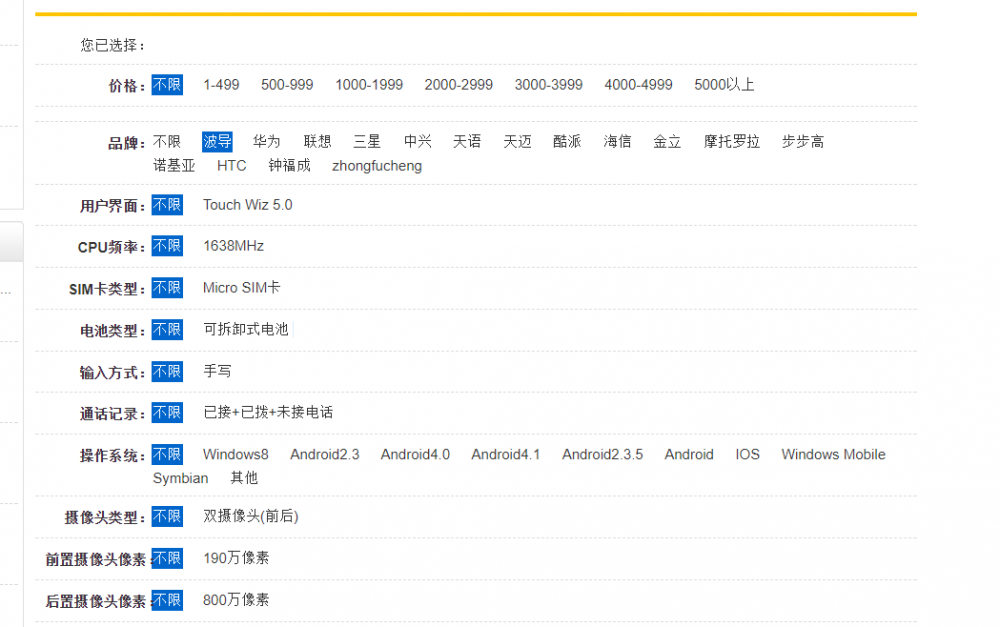
接收参数数据
/**
* 接收条件,查询出符合条件的商品
* @param brandId 品牌id
* @param price 价钱
* @param param 被选中的参数
* @return
*/
@RequestMapping("listItem.do")
public String listItem(Long brandId, String price, String param) {
return "phoneClassification";
}
参数我们已经知道了,那我们怎么写这个SQL语句呢??
我的分析是这样子的:
/**
根据价钱,品牌,被选中属性查询符合条件的商品
涉及到的表:
1.商品
2.商品
3.参数值
4.价钱
*/
SELECT *
FROM EB_BRAND brand, EB_ITEM item, EB_PARA_VALUE para, EB_SKU sku
WHERE brand.BRAND_ID = item.BRAND_ID AND
para.ITEM_ID = item.ITEM_ID AND
sku.ITEM_ID = item.ITEM_ID AND
brand.BRAND_ID = 1002 AND
sku.SKU_PRICE BETWEEN 1 AND 800000 AND
para.PARA_VALUE = 'Android4.0';
在价钱中是一个范围,因此我们用between and 语法,而我们的参数传递过来可能是与很多的,因此只要我们使用动态SQL循环就行了。
因此,我们的mapper中的SQL是这样子的。
<select id="listItem" parameterType="map" resultMap="listItemRM">
SELECT item.*, sku.SKU_PRICE
FROM EB_BRAND brand, EB_ITEM item, EB_PARA_VALUE para, EB_SKU sku
<where>
brand.BRAND_ID = item.BRAND_ID
para.ITEM_ID = item.ITEM_ID AND
sku.ITEM_ID = item.ITEM_ID AND
<if test="brandId!=null">
brand.BRAND_ID = #{brandId} AND
</if>
<if test="minPrice!=null">
sku.SKU_PRICE BETWEEN #{minPrice} AND #{maxPrice} AND
</if>
<if test="paraList!=null">
<foreach collection="paraList" item="val" >
para.PARA_VALUE = #{val} AND
</foreach>
</if>
</where>
</select>
由于我们的展示数据还需要价钱,返回的basemap不够用。我们就新创建了一个Map
<resultMap type="com.rl.ecps.model.EbItem" id="listItemRM" extends="BaseResultMap">
<result column="sku_price" property="skuPrice"/>
</resultMap>
在实体中给予对应的属性
private BigDecimal skuPrice;
public BigDecimal getSkuPrice() {
return skuPrice;
}
public void setSkuPrice(BigDecimal skuPrice) {
this.skuPrice = skuPrice;
}
编写Dao和Service
dao实现
public List<EbItem> listItem(Map<String, Object> map) {
return this.getSqlSession().selectList(nameSpace + "listItem", map);
}
service实现
public List<EbItem> listItem(Long brandId, String price, String param) {
Map<String, Object> map = new HashedMap();
map.put("brandId", brandId);
//将价钱进行分割成两部分
if (StringUtils.isNotBlank(price)) {
String[] strings = price.split(",");
map.put("minPrice", strings[0]);
map.put("maxPrice", strings[1]);
}
//分割并装载到map中
List<String> list = new ArrayList<String>();
if (StringUtils.isNotBlank(param)) {
String[] paras = param.split(",");
for (String para : paras) {
list.add(para);
}
map.put("paraList", list);
}
return itemDao.listItem(map);
}
前台请求
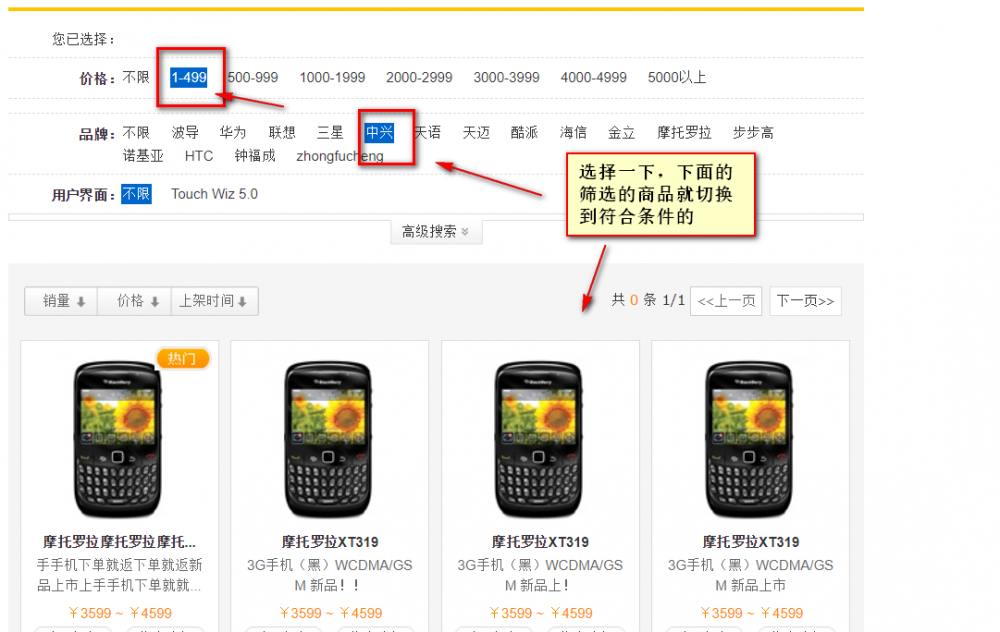
基于这么一个需求, 当我们点击一个条件的时候,我们要把当前所有获取的条件都获取出来。然后提交给服务器端就行了!
在点击选中事件上,我们获取数据
- 其实自定义的值可以使用一个就行了。没必要分三个那么多(可以统一获取) ..
//使用变量状态我们的数据
var price = "";
var brandId = "";
var paraStr = "";
$(".filter li a").each(function () {
//拿到选中的超链接
var clazz = $(this).attr("class");
if (clazz == "here") {
//得到他们的类型【在html中我们自定义了3个类型】
var myType = $(this).attr("myType");
//根据不同的类型,对其进行不同的操作
if (myType == "brand") {
brandId = $(this).attr("myBrandValue")
} else if (myType == "price") {
price = $(this).attr("myPriceValue");
} else if (myType == "para" && $(this).attr("myParaValue") != null) {
var val = $(this).attr("myParaValue");
paraStr = paraStr + val+",";
}
}
});
alert(price + "---" + brandId + "---" + paraStr);
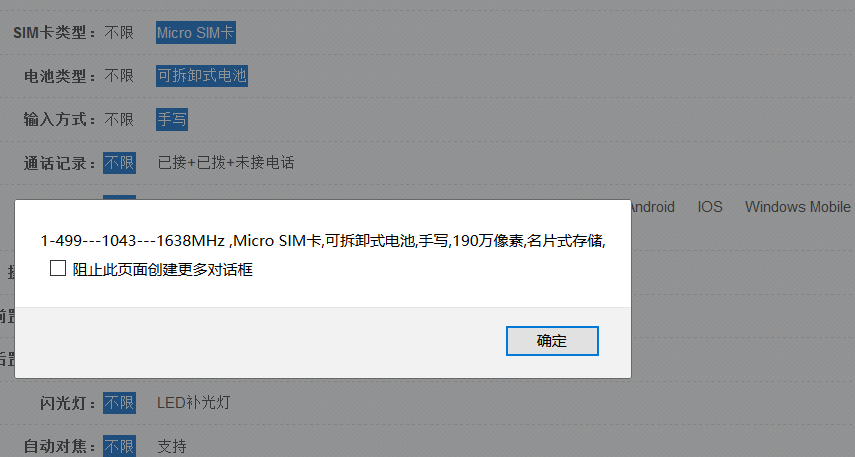
修改iframe的请求路径,把我们的参数带过去
var iframePath = "${path}/item/listItem.do?price="+price+"&brandId="+brandId+"¶Str="+paraStr;
$("#itemListIframe").attr("src", iframePath);
controller
/**
* 接收条件,查询出符合条件的商品
*
* @param brandId 品牌id
* @param price 价钱
* @param paraStr 被选中的参数
* @return
*/
@RequestMapping("/listItem.do")
public String listItem(Long brandId, String price, String paraStr, Model model) {
// TODO 基本效果出来了,但条件查询还有问题。
List<EbItem> items = itemService.listItem(brandId, price, paraStr);
model.addAttribute("items", items);
return "phoneClassification";
}
我们在查询的时候,发现很多相同价钱的手机都展示出来的。讲道理我们只要展示最低价钱那款就行了
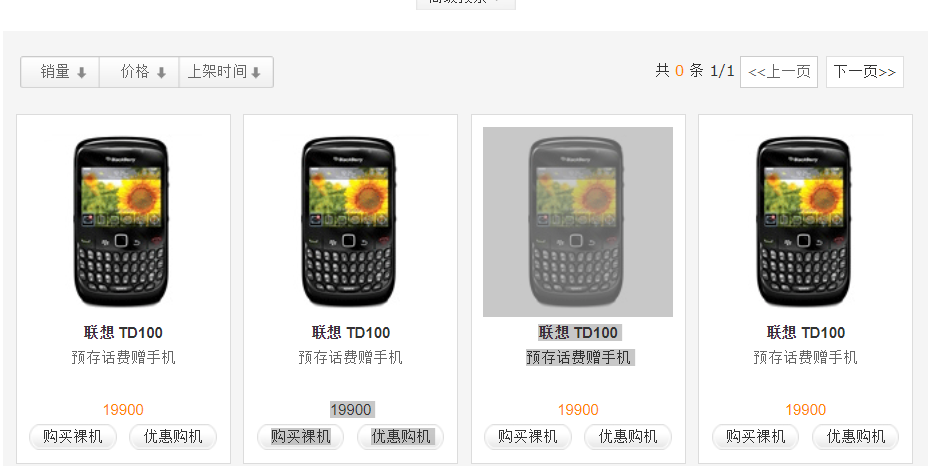
想要展示最低价那款,还是要去修改SQL语句。需要用到分组函数了。
首先我有这么一个商品
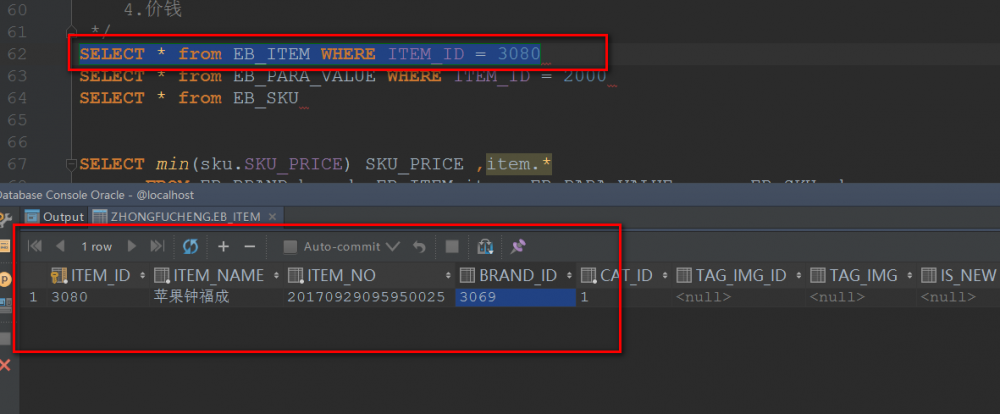
它有两个最小销售单元,一般我们在页面上显示最便宜的那个就行了。

我们的SQL语句可以写成这样:
SELECT min(sku.SKU_PRICE) SKU_PRICE ,item.*
FROM EB_ITEM item, EB_PARA_VALUE para, EB_SKU sku
WHERE para.ITEM_ID = item.ITEM_ID
AND sku.ITEM_ID = item.ITEM_ID
AND item.BRAND_ID = 3069
AND sku.SKU_PRICE BETWEEN 1 AND 1000000
AND para.PARA_VALUE = 'Android'
AND item.ITEM_ID=3080
GROUP BY item.ITEM_ID,
item.ITEM_NAME,
item.ITEM_NO,
item.BRAND_ID,
item.CAT_ID,
item.TAG_IMG_ID,
item.TAG_IMG,
item.IS_NEW,
item.IS_GOOD,
item.IS_HOT,
item.PROMOTION,
item.AUDIT_STATUS,
item.SHOW_STATUS,
item.IMGS,
item.KEYWORDS,
item.PAGE_DESC,
item.ITEM_RECYCLE,
item.ON_SALE_TIME,
item.CHECK_TIME,
item.UPDATE_TIME,
item.UPDATE_USER_ID,
item.CREATE_TIME,
item.CHECKER_USER_ID,
item.FULL_PATH_DEPLOY,
item.FULL_PATH_DEPLOY_OFFER,
item.ORIGINAL_ITEM_ID,
item.LAST_STATUS,
item.MERCHANT_ID,
item.ITEM_SORT,
item.SALES,
item.CREATE_USER_ID,
item.SIM_LEVEL,
item.GIFT_DESC,
item.GIFT_IMG,
item.GIFT_SHOW_TYPE,
item.IMG_SIZE1
order by item.item_id desc
修改一下Mapper中的SQL语句:
<select id="listItem" parameterType="map" resultMap="listItemRM">
SELECT item.*, min(sku.SKU_PRICE) sku_price
FROM EB_ITEM item, EB_PARA_VALUE para, EB_SKU sku
<where>
para.ITEM_ID = item.ITEM_ID AND
sku.ITEM_ID = item.ITEM_ID
<if test="brandId!=null">
AND item.BRAND_ID = #{brandId}
</if>
<if test="minPrice!=null">
AND sku.SKU_PRICE BETWEEN #{minPrice} AND #{maxPrice}
</if>
<if test="paraList!=null">
<foreach collection="paraList" item="val">
AND para.PARA_VALUE = #{val}
</foreach>
</if>
</where>
GROUP BY item.ITEM_ID,
item.ITEM_NAME,
item.ITEM_NO,
item.BRAND_ID,
item.CAT_ID,
item.TAG_IMG_ID,
item.TAG_IMG,
item.IS_NEW,
item.IS_GOOD,
item.IS_HOT,
item.PROMOTION,
item.AUDIT_STATUS,
item.SHOW_STATUS,
item.IMGS,
item.KEYWORDS,
item.PAGE_DESC,
item.ITEM_RECYCLE,
item.ON_SALE_TIME,
item.CHECK_TIME,
item.UPDATE_TIME,
item.UPDATE_USER_ID,
item.CREATE_TIME,
item.CHECKER_USER_ID,
item.FULL_PATH_DEPLOY,
item.FULL_PATH_DEPLOY_OFFER,
item.ORIGINAL_ITEM_ID,
item.LAST_STATUS,
item.MERCHANT_ID,
item.ITEM_SORT,
item.SALES,
item.CREATE_USER_ID,
item.SIM_LEVEL,
item.GIFT_DESC,
item.GIFT_IMG,
item.GIFT_SHOW_TYPE,
item.IMG_SIZE1
order by item.item_id desc
</select>
再次查看的时候,只出现一台了。
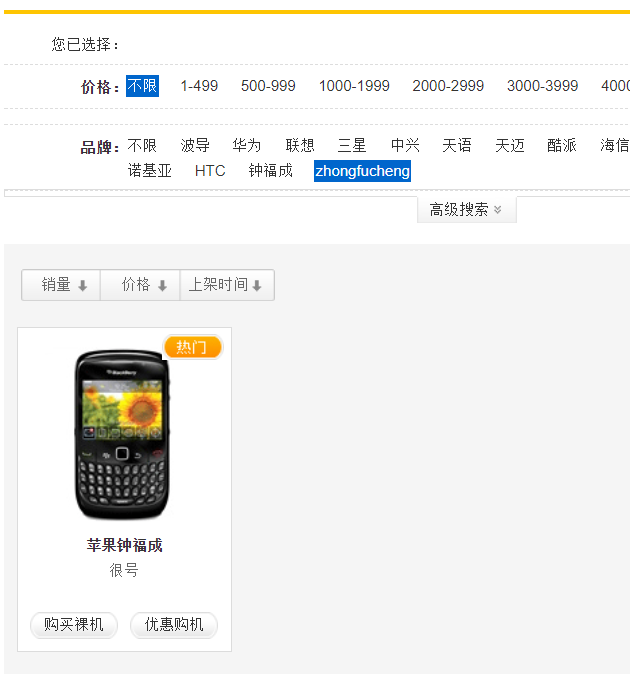
标准答案的SQL是使用exists关键字来进行查询的:在单表查询的情况下,看有没有符合条件的数据,如果符合,那么exists为ture
<select id="listItem" parameterType="map" resultMap="listItemRM">
select min(es.sku_price) sku_price, ei.*
from eb_item ei, eb_sku es
<where>
ei.item_id = es.item_id
<if test="minPrice != null">
and es.sku_price between #{minPrice} and #{maxPrice}
</if>
<if test="brandId != null">
and ei.brand_id = #{brandId}
</if>
<if test="paraList != null">
<foreach collection="paraList" item="paraValue">
and exists (select *
from eb_para_value t
where ei.item_id = t.item_id
and t.para_value = #{paraValue})
</foreach>
</if>
</where>
group by ei.ITEM_ID,
ei.ITEM_NAME,
ei.ITEM_NO,
ei.BRAND_ID,
ei.CAT_ID,
ei.TAG_IMG_ID,
ei.TAG_IMG,
ei.IS_NEW,
ei.IS_GOOD,
ei.IS_HOT,
ei.PROMOTION,
ei.AUDIT_STATUS,
ei.SHOW_STATUS,
ei.IMGS,
ei.KEYWORDS,
ei.PAGE_DESC,
ei.ITEM_RECYCLE,
ei.ON_SALE_TIME,
ei.CHECK_TIME,
ei.UPDATE_TIME,
ei.UPDATE_USER_ID,
ei.CREATE_TIME,
ei.CHECKER_USER_ID,
ei.FULL_PATH_DEPLOY,
ei.FULL_PATH_DEPLOY_OFFER,
ei.ORIGINAL_ITEM_ID,
ei.LAST_STATUS,
ei.MERCHANT_ID,
ei.ITEM_SORT,
ei.SALES,
ei.CREATE_USER_ID,
ei.SIM_LEVEL,
ei.GIFT_DESC,
ei.GIFT_IMG,
ei.GIFT_SHOW_TYPE,
ei.IMG_SIZE1
order by ei.item_id desc
</select>
总结
- 准备前台页面,在web.xml一样是需要加载我们Core模块的bean.xml文件。需要自己手动去写一个springMVC的配置文件。
- 在筛选后台的时候,接收类型可以分成三类
- 价钱
- 品牌Id
- 要被筛选的条件。
-
对于这三类,我们很容易就能够把他们显示出来。 最主要的问题是获取他们这些数据、然后根据这些数据进行查询
- 我是这样做的:把他们关联的表一次性写出来,内连接他们的相同条件。
- 价钱参数使用between and关键字来搜索
- 品牌用等值连接
- 被选中的参数用动态的SQL来进行查询
- 还有值得注意的就是最小销售单元,一般我们只会在页面上显示最低价的那款商品。因此我们用到分组函数。
- 我是这样做的:把他们关联的表一次性写出来,内连接他们的相同条件。
-
对于标准答案,是将被选中的参数使用exist关键字来对其进行过滤。一个条件对应一个exist。至于他俩有什么区别我倒不知道了,知道了再回来补吧。
- 那怎么获取这三类的值呢??可以在每个a标签上自定义类型,还有对应的值。当点击其中一个标签的时候,遍历这些标签,获取他们的值。
- 价钱使用字符串来接收,是一个范围。我们接收完在后台切割就行了。
- 品牌直接使用Long类型接收
- 被选中的标签也可以使用字符串来接收,同样在后台切割就行了。
-
由于我们有3个参数、Dao层使用map集合来接收。
- 本文标签: HTML BaseResultMap Features 配置 Collection XML src java bean js App SpringMVC ACE classpath map IO Select schema spring Service https 需求 list Word 服务器 sqlsession sql 遍历 总结 Property ip 数据 value http web 动态SQL cat Android 参数 JavaScript servlet UI id key core update mapper
- 版权声明: 本文为互联网转载文章,出处已在文章中说明(部分除外)。如果侵权,请联系本站长删除,谢谢。
- 本文海报: 生成海报一 生成海报二











![[HBLOG]公众号](https://www.liuhaihua.cn/img/qrcode_gzh.jpg)

